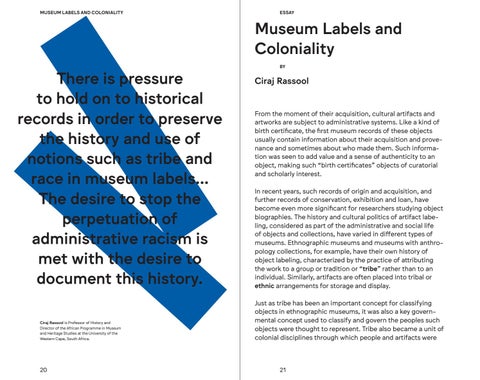MUSEUM LABELS AND COLONIALITY
ESSAY
Museum Labels and Coloniality There is pressure to hold on to historical records in order to preserve the history and use of notions such as tribe and race in museum labels… The desire to stop the perpetuation of administrative racism is met with the desire to document this history. Ciraj Rassool is Professor of History and Director of the African Programme in Museum and Heritage Studies at the University of the Western Cape, South Africa.
20
BY
Ciraj Rassool From the moment of their acquisition, cultural artifacts and artworks are subject to administrative systems. Like a kind of birth certificate, the first museum records of these objects usually contain information about their acquisition and provenance and sometimes about who made them. Such information was seen to add value and a sense of authenticity to an object, making such “birth certificates” objects of curatorial and scholarly interest. In recent years, such records of origin and acquisition, and further records of conservation, exhibition and loan, have become even more significant for researchers studying object biographies. The history and cultural politics of artifact labeling, considered as part of the administrative and social life of objects and collections, have varied in different types of museums. Ethnographic museums and museums with anthropology collections, for example, have their own history of object labeling, characterized by the practice of attributing the work to a group or tradition or “tribe” rather than to an individual. Similarly, artifacts are often placed into tribal or ethnic arrangements for storage and display. Just as tribe has been an important concept for classifying objects in ethnographic museums, it was also a key governmental concept used to classify and govern the peoples such objects were thought to represent. Tribe also became a unit of colonial disciplines through which people and artifacts were
21
